A few days ago, I came across a fascinating article from The Atlantic magazine comparing the outlook of the movies of today (especially movies about Iraq) to the movies of the decade that followed the Vietnam War. I've long felt that there's too much influence on today's culture by the people of the 1968 generation, who seem to want to view everything through the lens of events that happened between the assassination of John F. Kennedy and the resignation of Richard Nixon. (If you don't believe me, ask yourself why, when a football team is caught illegally taping its opponents, we have to have the goddamn -gate suffix attached to the name of the event.) I was reminded of this article last Friday when I was watching It Came From Beneath the Sea.
In the movie, Faith Domergue plays a female scientist who is called in by the military to investigate what turns out to be a giant octopus (courtesy of Ray Harryhausen) attacking boats at sea. At first, she really chafes at having to do the investigation -- and when the military brass are incredulous at her and her male colleague's hypothesis that they are facing a giant octopus, her initial reaction isn't to think it might be natural for people to disbelieve something so shocking, or even to think that they're simply having a fit of incompetency. No, she implies that they're disbelieving her with malice aforethought.
Now, military incompetency is nothing new. Humorists, and men in uniform, have been good-humored ribbing at their superiors for decades, if not centuries. Consider service comedies like Operation Petticoat, or even the dark humor in movies like Wake Island and Guadalcanal Diary. But this scene from It Came From Beneath the Sea struck me as one of the earliest I can remember in which a studio movie tried to portray the military as deliberately mendacious and unfeeling. It's de rigueur now, especially if it can be mixed with identity politics. (Indeed, one of the first movies which struck me with its presentation of military evil was Outbreak, in which smart female scientist Rene Russo outwits dumb male Dustin Hoffmann, and has to stop the military from bombing an entire town, which happens only through the intervention of the one black officer around, Morgan Freeman.) Considering the experience many in the 60s had with the unpopular war and draft in Vietnam, and the resulting politicization of culture that the 1968ers inflicted upon us, that's not necessarily surprising. Nowadays, of course, it's unoriginal and tedious, but I can't help but wonder if it was a surprise to the audiences of 1955. (Then again, they were probably all at the cinema for the Harryhausen effects.)
Are there any other earlier movies that show such intentional mendacity on the part of the US military?
Monday, March 31, 2008
The mendacious military
Posted by
Ted S. (Just a Cineast)
at
9:58 PM
0
comments
![]()
![]()
Sunday, March 30, 2008
Not as sick as Dark Victory
I've been laid up with a nasty cold the past 36 hours or so, barely making it through TCM's showing of The Great Escape. But being sick, I thought to myself, "What actors have made movies knowing that they're dying?" Not much of a blog topic, to be sure, but like I said, I'm sick and don't particulary feel like posting.
Edward G. Robinson was dying of cancer when he made Soylent Green, and as I understand it, he did not live to see the movie released. It's a shame, because his is probably the best performance in the movie.
Legend has it that another actor dubbed some of the lines for Humphrey Bogart in The Harder They Fall, since he, too, was dying at the time. But as far as I know, that's just an urban legend.
Finally, Spencer Tracy was in very poor health on the set of Guess Who's Coming to Dinner. And even more than Robinson or Bogart, he looked it, too.
Any other good sick-actor movies?
Posted by
Ted S. (Just a Cineast)
at
6:34 PM
0
comments
![]()
![]()
Labels: Spencer Tracy
Saturday, March 29, 2008
The lousy, lousy trailer
One of the things I like about TCM is how their upcoming movies are promoed through the use of vintage trailers that would have been shown to audiences back in the day. The trailers are often bombastic, puffing up the studios' stars to ridiculous dimensions that are good for a laugh. Also, the editing generally leaves something to be desired, with a doctrinaire use of wipes instead of cuts (especially for earlier movies).
However, what struck me last night is the physical quality of the trailers. Last night, TCM showed a trailer for A Ticklish Affair (March 31 at 3:00 PM ET), and I was surprised at the poorness of the print. The movie is in color, but the colors on this print were at best washed out. There was a slightly reddish tint to everything, but the actual reds in the scenes were faded to a dull, rusty hue. There also didn't seem to be much in the way of greens and blues, either.
It's not just Technicolor that suffers in the trailers. I've noticed that when trailers for older (1930s and 1940s) black and white movies are aired, the prints look as though they're almost bad, fuzzy public domain prints, and certainly nothing like the quality of the actual finished product.
I can think of two good reasons why trailers would have a lower visual quality than the full movies we see:
1. The studios wouldn't put as much effort into making a trailer as they would into making the finished product. I can't imagine the top directors going into the editing room and watching the creation of the advertising trailers the way they would with the daily rushes of the movies they were working on. Also, I would doubt that anywhere near as much time was spent on creating the promos as would be spent on making the equivalent amount of finished movie.
2. The studios would have had little need to preserve the trailers. It's fairly well known that studios have been remiss about preserving their actual feature movies, with movies being lost for a variety of reasons. Considering the cost of movie preservation, who would spend the money to preserve the trailers, too?
Does anybody older know whether the quality of the trailers was just as bad originally as what we see on TCM today?
Posted by
Ted S. (Just a Cineast)
at
10:19 AM
0
comments
![]()
![]()
Friday, March 28, 2008
A surprisingly good original
Many classic movies are remakes of earlier movies. Here, I don't mean "classic" in the sense of "old", the way it is more or less used in the name of cable channel Turner Classic Movies; I'm referring here to some of the great movies of all time. A lot of these movies are based on earlier source material: movies such as the Judy Garland of The Wizard of Oz, Humphrey Bogart's The Maltese Falcon, and Charlton Heston's Ben-Hur are all based on books; all of these books had previously been made into movies before the versions we know and recognize today as the "definitive" movie versions of these books.
Plays have also been subjected to multiple movie treatments. Not only are there the public domain plays such as those of William Shakespeare, contemporary plays like the recently-mentioned Outward Bound have been made into movies on more than one occasion. And so it is with Gaslight. The 1944 movie starring Charles Boyer and Ingrid Bergman is probably best remembered, as it won Bergman an Oscar, but this morning, TCM showed the 1940 version. I was surprised at just how good it was.
The 1940 version was made in the UK by British International pictures, and distributed in the US by MGM (who made the 1944 version). Having been made in the UK, it's to be expected that the production values aren't quite as good as what one could expect from the most prestigious of the Hollywood studios. But the cast is quite effective. Anton Walbrook plays the role reprised by Charles Boyer, that of the man trying to drive his wife mad so that he can get at her aunt's jewels. The wife in the 1940 version is played by Diana Wynyard, who might be the weak link in this movie: she doesn't hit the emotional depth that Bergman does. The housemaid is also better in the 1944 version; Angela Lansbury is shockingly good as the saucy young girl helping her boss drive his wife mad; in the 1940 version, she comes across as much more flat. But one role that's better in the 1940 version is the man who helps our lady-in-distress discover the truth about her husband. In the 1944 version, that role is filled by Joseph Cotten playing a Scotland Yard detective, a role for which he's thoroughly unsuited. In the original, Frank Pettingell plays Rough, a retired cop looking to let the house next to Walbrook's; Pettingell plays his role with a sense of verve and forwardness that is entirely appropriate, and makes his character seem entirely realistic.
Fortunately, both versions of Gaslight are available on DVD.
Posted by
Ted S. (Just a Cineast)
at
4:04 PM
0
comments
![]()
![]()
Labels: British
Thursday, March 27, 2008
She's not there
Despite already having posted to the blog today, I wanted to mention an intriguing movie airing on TCM tomorrow, at 4:30 PM ET: Bunny Lake is Missing.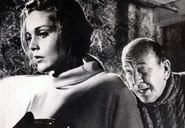 Carol Lynley stars as Ann Lake, a newcomer to the swinging London of the 1960s. She's got a four-year-old daughter, Bunny, whom she drops off at a day care. However, Bunny never returns home. And when Ann reports the child missing, she's unable to find anybody at the day care who had any knowledge of seeing the child. Worse, there's no longer any evidence at her flat that Bunny Lake even exists.
Carol Lynley stars as Ann Lake, a newcomer to the swinging London of the 1960s. She's got a four-year-old daughter, Bunny, whom she drops off at a day care. However, Bunny never returns home. And when Ann reports the child missing, she's unable to find anybody at the day care who had any knowledge of seeing the child. Worse, there's no longer any evidence at her flat that Bunny Lake even exists.
Helping her is her extremely arrogant brother, Stephen, played by Keir Dullea. He should know that he's got a niece, since Ann and Bunny are sharing a flat with him. And he's trying to get the police inspector (playedy by Laurence Olivier) to believe him.
It's an interesting premise for a movie, and the grim London of the 1960s, when it was going through its long decline from Empire, is quite a good setting for a story. (The same ugly side of London can be well seen in a movie like To Sir With Love, or even Alfred Hitchcock's Frenzy.) The 1960s are also well represented by the soundtrack, in the form of the British rock group The Zombies, who are repeatedly seen on television screens as part of a performance on a BBC TV show. They don't sing their appropriate (at least for this movie) song "She's Not There", instead we get the also-appropriate "Just Out of Reach" and "Remember You". Another plus is that all three of the main cast members do quite a good job here. Unfortunately, though, the movie takes a turn around the bend about three-quarters of the way into the movie that left me feeling as though I had been cheated; the final quarter felt to me to be tacked-on, and not fitting with the rest of the plot.
As for the supporting cast, the man in the picture above with Carol Lynley is Noel Coward, in the role of the Lakes' landlord. That's not his only function, though; watch for a funny scene in which we find that this landlord is also a pervert, asking the police to whip him!
Otto Preminger directed; if you miss the TCM showing, it's available on DVD.
Posted by
Ted S. (Just a Cineast)
at
10:56 PM
0
comments
![]()
![]()
Labels: British
Richard Widmark, 1914-2008

Widmark was probably best known for playing bad guys, notably in his first movie, Kiss of Death which has a memorable scene of Widmark pushing a wheelchair-bound little old lady down a flight of stairs. There's also one of my favorites, the 1950 No Way Out, in which he plays a vicious racist who terrorizes black doctor Sidney Poitier, or as a hoodlum whose stolen more than he can handle in Pickup on South Street.
But he also played some memorable good guys, notably the prosecuting attorney in Judgment at Nuremberg, or as the man who finds that Marilyn Monroe has gone psychotic in Don't Bother to Knock. (Apparently, he didn't think Monroe could act. Oops.)
One of Widmark's notable later roles is as the murder victim in Murder on the Orient Express.
Unfortunately, Widmark started as a contract player at Fox, so a lot of his earlier movies don't show up on TV all that often. TCM will be showing three of his later movies in prime time on Friday, April 4, as their tribute to him.
Posted by
Ted S. (Just a Cineast)
at
10:50 AM
0
comments
![]()
![]()
Labels: Obituary
Wednesday, March 26, 2008
Outward Bound

TCM is showing a very interesting early talkie at 9:00 AM on March 27: Outward Bound. Douglas Fairbanks, Jr. stars as Henry who, with his wife, is one of several passengers on a mysterious ship. They're not certain where the ship is headed, and there doesn't seem to be much of a crew. This greatly bothers some of the passengers (especially an alcoholic played by Leslie Howard, in his first American film), while others are a bit equivocal about it.
I don't want to give the plot away by pointing out why everybody is on that ship, and instead want to point out a different plot element that is in its own right interesting: the use of sound effects. The passengers can hear various clanking noises that presumably come from parts of the ship, although when they search for the source of these noises, they're unable to find anything. Also, a key plot point is a pet dog, whose off-camera barking can be heard. Back in 1930, when this movie was made, the studios didn't know how to use sound, giving the audiences either movies with lots of songs (even when the songs are in odd places), or what are effectively filmed productions of stage plays. (For the record, Outward Bound is itself based on a stage play of the same title.) As such, Outward Bound has parts where it seems to drag, even though it only has a runtime of about 80 minutes. But where Outward Bound is unique is those sound effects, which help drive the plot in a way very few other early talkies were doing.
Outward Bound was remade in 1944 as Between Two Worlds, with much a much bigger budget, better production values, and a cast to rival that of the original: John Garfield stars, with Casablanca castaways Paul Henried and Sydney Greenstreet amongst the supporting actors. Personally, I prefer the former. Sadly, though, neither of these movies is available on DVD.
Posted by
Ted S. (Just a Cineast)
at
11:04 AM
0
comments
![]()
![]()
Labels: Leslie Howard
Tuesday, March 25, 2008
Val Lewton
 I've commented in the past that a good story is just as important for making a good movie as A-list actors or elaborate special effects. One of the best exemplars of this idea is the producer Val Lewton. Lewton worked as a producer at RKO in the 1940s, making horror movies on B budgets that, thanks to intelligent script writing and direction that creates the horror in that which is unseen, leaving the viewer to imagine the frightening things himself, are just as good as any horror movie made today.
I've commented in the past that a good story is just as important for making a good movie as A-list actors or elaborate special effects. One of the best exemplars of this idea is the producer Val Lewton. Lewton worked as a producer at RKO in the 1940s, making horror movies on B budgets that, thanks to intelligent script writing and direction that creates the horror in that which is unseen, leaving the viewer to imagine the frightening things himself, are just as good as any horror movie made today.
One of Lewton's best movies, The Seventh Victim, is airing at 6:00 AM ET on March 26 on TCM. In The Seventh Victim, Kim Hunter makes her film début as Mary Gibson, young woman at a Catholic school whose sister Jacqueline has headed for the big city, seemingly never to be seen again, and saddling her with tuition debts. The school administrators are naturally worried, as is Mary, so she heads off for the city determined to find out what has happened to her sister.
What Mary finds is shocking: Jacqueline has joined an odd religious sect that people today would consider a cult. And, as is the case with cults, they generally try to get their members to do things they otherwise would not do, deeming it not in their best interests. But what is this cult going to do to Jacqueline? Can Jacqueline stop herself? Or can Mary stop Jacqueline?
There's relatively little violence in this movie; what violence there is is implied by being depicted in the shadows -- as opposed to, say, Alfred Hitchcock's famous shower scene in Psycho. And yet, not actually showing the violence still leaves it just as frightening a prospect: after all, we all know what violence looks like.
The Seventh Victim isn't as well-remembered today as Lewton's other masterpiece, The Cat People, but it's just as good. In addition to being on TV tomorrow, it's also available on DVD. I can give this movie a strong recommendation.
Posted by
Ted S. (Just a Cineast)
at
10:50 AM
0
comments
![]()
![]()
Monday, March 24, 2008
March Madness
It only recently dawned on me that the phrase "March Madness" could describe TCM's look at psychiatry in the movies that has been going on all this month. Of course, the phrase "March Madness" is normally used in conjunction with the NCAA college basketball championships that started this past weekend. Basketball hasn't been such a popular subject in the movies, compared to either baseball or football. It's probably got a lot to do with the fact that basketball was invented well after the development of baseball and football, and that it only became popular much later than either of the other two sports. The NCAA basketball championships didn't begin until the 1930s, and the NBA wasn't inaugurated until after World War II. (By the same token, there's relatively little professional football featured in movies from the studio era; college football was much more popular until TV came along and made the NFL popular with the 1958 NFL Championship game.)
But there are a few earlier movies with basketball scenes in them.
- Angels With Dirty Faces. Pat O'Brien plays a priest who is shown refereeing a particularly violent basketball game with the Dead End Kids; the Dead End Kids don't start playing more by the rules until gangster James Cagney starts knocking them around. (Apparently, the Dead End Kids were generally hell-raisers on the set, until Cagney stepped on the set. When Leo Gorcey got fresh with Cagney for the first time, Cagney responded by decking Gorcey!)
- The Bachelor and the Bobby-Soxer. Shirely Temple's boyfriend, played by Johnny Sands (at least, he likes her -- she's in love with Cary Grant), is a high-school basketball player whose game goes to pieces because he's not getting any attention from Miss Temple. Note the narrow lane under the basket, the lack of a three-point line, and the incredibly short shorts that were the vogue for basketball players until the University of Michigan's "Fab Five" came along in 1990.
- The Absent-Minded Professor. Fred MacMurray's invention of "flubber" helps lead his college's basketball team to an improbable victory.
IMDb lists all three movies as being available on DVD.
Posted by
Ted S. (Just a Cineast)
at
9:14 PM
0
comments
![]()
![]()
Labels: Cary Grant
Sunday, March 23, 2008
Jack Carson sighting

Jack Carson was the subject of my first serious blog post. I'd just like to add a quick mention that perhaps his best role, that of Wallace Fay in Mildred Pierce is airing tonight on TCM at 9:30 ET as part of TCM's birthday salute to Joan Crawford.
Posted by
Ted S. (Just a Cineast)
at
10:18 AM
0
comments
![]()
![]()
The original Dogville
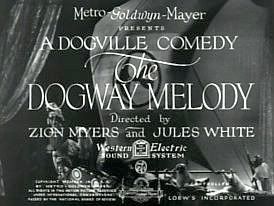
As I intimated yesterday, the introduction of talking pictures resulted in the studios having to adjust their picture-making techniques: when they didn't the result was very stagey. One way the studios experimented at the beginning of the talking picture era was in the making of short subjects. New talent and techniques could be tried, and if things didn't go well (and there are some creaky early talkie shorts out there!), you didn't go to anywhere near as much expense as you would have had you made a feature.
One of the most interesting series of shorts was the Dogville series. From 1929 to 1931, MGM produced a series of nine two-reelers parodying popular films of the day, with the premise that all of the cast members were, as the name implies, dogs. The title card above, from Dogway Melody, is an obvious spoof of the popular musical The Broadway Melody. Other titles included College Hounds, a sendup of the popular college football movies of the day; and So Quiet on the Canine Front, which was a remake of sorts of All Quiet on the Western Front. Looking back nearly 80 years, it's easy to suggest that these poor dogs are being abused, but even today, there are lots of people who like to dress up their dogs, and, as we've seen from "Stupid Pet Tricks" on David Letterman's show, people will still train their dogs to do all sorts of odd things.
Anyhow, I mention the Dogville shorts because TCM is airing one of them soon:  Trader Hound is coming up after Harriet Craig and before the film it spoofs, Trader Horn, on March 24. Harriet Craig airs at 6:00 PM ET, with Trader Horn kicking off prime time at 8:00 PM ET. TCM's online schedule lists the start time as 7:44 PM ET, but Harriet Craig only runs about 95 minutes, so if you're looking to see this, you may want to watch from about 7:35 PM.
Trader Hound is coming up after Harriet Craig and before the film it spoofs, Trader Horn, on March 24. Harriet Craig airs at 6:00 PM ET, with Trader Horn kicking off prime time at 8:00 PM ET. TCM's online schedule lists the start time as 7:44 PM ET, but Harriet Craig only runs about 95 minutes, so if you're looking to see this, you may want to watch from about 7:35 PM.
At least some of the Dogway shorts are available as extras on DVDs of other movies; the Dogway Melody is naturally a short on the Broadway Melody DVD.
Posted by
Ted S. (Just a Cineast)
at
10:16 AM
0
comments
![]()
![]()
Labels: Short
Saturday, March 22, 2008
Please release me, Part 1
I was dismayed to discover that Oscar's Best Picture of 1933, Cavalcade, is not available on DVD (despite what the IMDb page says).
Based on a play by Noel Coward, Cavalcade is an Upstairs, Downstairs-like look at the lives of two families from the start of the 20th century, through to 1933, when the movie was released. The rich "upstairs" family, the Marryots, are played by Diana Wynyard and Clive Brook, while the servant couple, the Bridges, is played by Una O'Connor and Herbert Mundin (who would later be romantically teamed again in The Adventures of Robin Hood). Wynyard and O'Connor both do fine jobs, but the rest of the movie is a bit lacking. Coward wasn't quite as good at writing drama as he was at comedy; the acting is staticky even by the standards of an early talkie; and the cavalcade of events is ridiculously predictable.
In one scene, for example, set in 1908, one of the Marryot sons talks with his girlfriend about taking their honeymoon on a ship, when a ship passes at the seaside resort they're at. You can guess what happens next: the scene shifts to April 14, 1912, aboard the Titanic. (Sadly, there were no Nazis in this version of the Titanic disaster; the scene ends when they show us ship the couple is aboard in in fact the Titanic.) World War I similarly affects everybody, but surprisingly, nobody seems to be affected by the Crash of 1929 and the associated Great Depression: the action jumps almost immediately from the end of World War I to 1932, with only a montage of the vice associated with the 1920s.
One person worth watching, however, is a dancing Fanny Bridges at the age of about 10 winning a teddy bear in a dancing competition: that's a young Bonita Granville.
Despite Cavalcade's flaws, it would be nice to see it available on DVD so that people can judge its quality for themselves.
Posted by
Ted S. (Just a Cineast)
at
7:37 PM
0
comments
![]()
![]()
Labels: please release me
Friday, March 21, 2008
Happiness is a thing called Joe
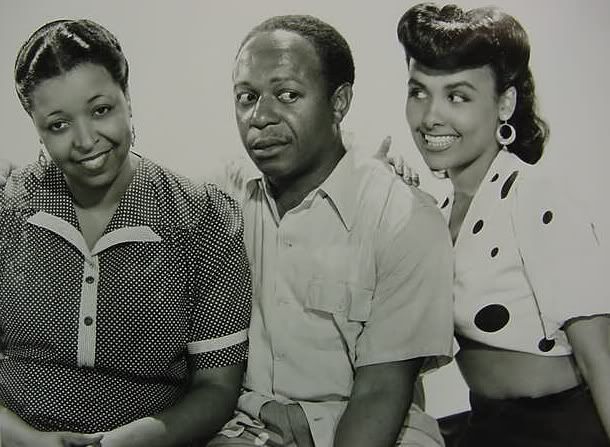
From left: Ethel Waters, Eddie "Rochester" Anderson, Lena Horne
Easter is this weekend, and TCM is playing a whole day's worth of movies befitting the holiday. One of my favorites is Cabin in the Sky, airing at 10:15 PM ET on March 22. Based on a Broadway musical, this morality play stars Ethel Waters as Petunia, a deeply-religious woman who's trying to get her husband Joe (Eddie "Rochester" Anderson) to stop gambling and lead a generally less sinful life. Unfortunately for her, matters come to a head one night when Joe gets shot while gambling, and faces a battle for his life.
That's not the only battle though: God and Lucifer also stage a battle for Joe's soul. God will gain Joe's soul if Joe can remain good for six months; otherwise, Joe's soul goes to Lucifer, who naturally tries to tempt Joe. The main source of temptation is the lovely Georgia Brown (Lena Horne). When Joe has a putatively winning ticket for the Irish Sweepstakes but discards it, it's she who brings the ticket back to him, and she who tempt him away from Petunia.
But there's so much more to this movie. One of the very few studio movies with an all-black cast, Louis Armstrong has a brief appearance as one of Lucifer's "idea men", and Duke Ellington appears as himself, leading the band at a juke joint. Of course, this was the 1940s, when segregation still reigned supreme, so some will see subtle elements of racism in the production. The characters are at best archetypes, if not caricatures; the production was in black-and-white when a lot of other MGM musicals of the day were being shot in glorious Technicolor (eg. Du Barry Was a Lady, also from 1943); and many of the actors are given all-too-brief parts (especially Louis Armstrong). Still, it's amazing that such a movie was made.
And it's not just a black movie: as a morality play, it tells a story of good versus evil that crosses all racial boundaries. Cabin in the Sky was the first major movie directed by Vincente Minnelli, and is available on DVD.
Posted by
Ted S. (Just a Cineast)
at
12:08 PM
0
comments
![]()
![]()
Labels: musical
Thursday, March 20, 2008
Paul Scofield, 1922-2008
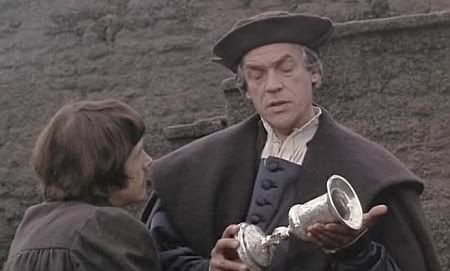
Paul Scofield hands a silver chalice to John Hurt in A Man For All Seasons
Paul Scofield, the actor who won a Best Actor Oscar for portraying Sir Thomas More in the 1966 movie A Man For All Seasons, has died at the age of 86.
The plot of A Man For All Seasons is fairly simple: Scofield plays Sir Thomas More, a devout Roman Catholic serving as Lord Chancellor to English King Henry VIII (played by Robert Shaw). Henry's marriage to Catherine of Aragon has failed to yield any surviving sons, and Henry has fallen in love with young Anne Boleyn (played in a brief cameo by Vanessa Redgrave). Of course, the Catholic Church has a thing against divorce, and His Majesty is trying to find some way to get around this problem.
This is set against a backdrop of a corrupt political establishment (there's nothing new under the sun), in which many people are perfectly willing to abandon their faith and bow to the King's wishes, if only because it will allow them to get ahead. More, however, being devout, will have nothing of this; considering the King's marriage to Catherine licit under Catholic Canon Law, he will not under any circumstances sanction the divorce and remarriage to Anne Boleyn, instead being willing to resign his post as Lord Chancellor when Henry creates his own (Anglican) Church.
Unfortunately, More is not allowed to live out the rest of his days quietly, as the King is forcing everybody to take a loyalty oath; the oath would require More to reverse publicly his stance on the King's marriage to Anne Boleyn, or else be in violation of the oath by continuing to be a Catholic. More, consequently, refuses to take the oath, and is arrested and put on trial for high treason.  More, in his defense, delivers a blistering indictment of the King's actions and the political and religious establishments' willingness to abandon their moral values for political expediency, but the defense is obviously all for naught: the whole oath and trial was little more than a sham to get everybody to come to the King's position, or else get rid of those who did not agree with the King. More is sentenced to be executed, and dies for his beliefs.
More, in his defense, delivers a blistering indictment of the King's actions and the political and religious establishments' willingness to abandon their moral values for political expediency, but the defense is obviously all for naught: the whole oath and trial was little more than a sham to get everybody to come to the King's position, or else get rid of those who did not agree with the King. More is sentenced to be executed, and dies for his beliefs.
The cast is excellent; in addition to Scofield, Wendy Hiller plays his wife, Alice; a young and lovely Susannah York plays his daughter, Margaret; Vanessa Redgrave's brother Corin plays Margaret's betrothed, William Roper; John Hurt appears in his first major movie as Richard Rich, a man looking to get ahead at the royal court; Leo McKern plays Thomas Cromwell; and Orson Welles has a small role as Cardinal Wolsey. Directing duties were more than capably handled by the great Fred Zinnemann, in a job that must have felt like a reprise of High Noon.
A Man For All Seasons is available on DVD and is well worth watching.
Posted by
Ted S. (Just a Cineast)
at
12:10 PM
0
comments
![]()
![]()
Labels: Fred Zinnemann, Obituary
Wednesday, March 19, 2008
The master of suspense
TCM aired Alfred Hitchcock's Rope yesterday afternoon. Despite not normally receiving the acclaim of movies like Rear Window, Psycho, or Vertigo, Rope is on of the movies that best shows just how good Hitchcock was at creating suspense. We know right away at the beginning of the movie that there's been a murder: Hitchcock shows us how the roommates Brandon (John Dall) and Philip (Farley Granger) strangle their friend David (Dick Hogan), and hide his body in a chest. They then proceed to throw a dinner party ostensibly in his honor, and serve the buffet off of the chest in which David's body is stored! Into all this walks their housemaster from prep school, Rupert Cadell (played by James Stewart in the first of four movies he made with Hitchcock). We know there's been a murder, but he, and the other guests, don't. And so, the question becomes, are Brandon and Philip going to get away with murder? And if not, how are they going to be caught? That was Hitchcock's thesis about the difference between suspense, murder, and horror: that we in the audience know something the characters don't.
We know right away at the beginning of the movie that there's been a murder: Hitchcock shows us how the roommates Brandon (John Dall) and Philip (Farley Granger) strangle their friend David (Dick Hogan), and hide his body in a chest. They then proceed to throw a dinner party ostensibly in his honor, and serve the buffet off of the chest in which David's body is stored! Into all this walks their housemaster from prep school, Rupert Cadell (played by James Stewart in the first of four movies he made with Hitchcock). We know there's been a murder, but he, and the other guests, don't. And so, the question becomes, are Brandon and Philip going to get away with murder? And if not, how are they going to be caught? That was Hitchcock's thesis about the difference between suspense, murder, and horror: that we in the audience know something the characters don't.
Hitchcock gives us some excellent characterizations here, as Brandon is confident to the point of hubris, as well as being domineering toward Philip and manipulative. Philip, on the other hand, is much less comfortable with the idea of murder, to the point of becoming unhinged and pitiable. Brandon and Philip are clearly supposed to be a gay couple, although thanks to constraints of the Production Code, this couldn't be mentioned -- but it actually works to film's benefit that the homosexual relationship is only (obviously) implied. A modern-day remake would probably try to make the relationship much more explicit (and graphic), if not campy. (It must also be pointed out that the movie, and the play on which it was based, were drawn from the real-life case of Chicago thrill-killers Leopold and Loeb, who were in fact gay.) And James Stewart is excellent as Rupert Cadell, the philosopher whose ideas inspired Brandon and Philip to commit murder; Rupert becomes rightly horrified when he not only realizes that his two former charges have committed murder, but learns why they've committed murder. Stewart displays an emotional register that's deeper than anything he had before World War II (even though Stewart was great in movies such as Mr. Smith Goes to Washington and The Philadelphia Story), suggesting that he was drawing on whatever dark experiences he had during the war to play Rupert.
Much has been made of the technical aspects of Rope: Hitchcock wanted to make Rope evocative of a stage play, and made the movie a series of very long takes. The film canisters could only hold about nine or ten minutes of film at any one time, so there are a number of shots in which Hitchcock hides the camera behind a dark item such as a jacket or the chest, and has a discreet dissolve there to where the new canister of film begins. However, the commonly stated claim that these are the only cuts is untrue: Hitchcock eventually realized that he would be limited by the amount of film that could be shown on one projection reel, which was about 20 minutes; so every 18 minutes or so there is a "hard" cut as opposed to the dissolves.
Rope is available on DVD, so if you missed TCM's showing, you're not out of luck.
Posted by
Ted S. (Just a Cineast)
at
11:42 AM
0
comments
![]()
![]()
Labels: Alfred Hitchcock
Tuesday, March 18, 2008
A Treat Williams treat
Over on the TCM boards, somebody recommended the movie version of Hair, starring Treat Williams. His name reminded me of a little-known movie of his that, happily, is available on DVD: Where the Rivers Flow North.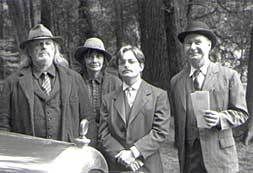 Williams only has a small part, as a promoter of a carnival wrestler. The starring role goes to Rip Torn, who plays Noel Lord, a man eking out a meager existence in the Northeast Kingdom of Vermont in the 1920s as a logger. However, he's about to face the loss of his land, as an electric company wants to bring electricity to the region by damming the local river, which would flood his land. Of course, they're offering money to all the people whose land will be lost, but Noel is one of the only ones who doesn't want to take the money. The power company sweetens their offer, but there's always the threat of their using eminent domain laws to force a sale. Meanwhile, Noel's love interest, the Native American woman Bangor, played by Tantoo Cardinal, is of the opinion that they should accept the power company's offer, so that they can move west and buy a new plot of forest.
Williams only has a small part, as a promoter of a carnival wrestler. The starring role goes to Rip Torn, who plays Noel Lord, a man eking out a meager existence in the Northeast Kingdom of Vermont in the 1920s as a logger. However, he's about to face the loss of his land, as an electric company wants to bring electricity to the region by damming the local river, which would flood his land. Of course, they're offering money to all the people whose land will be lost, but Noel is one of the only ones who doesn't want to take the money. The power company sweetens their offer, but there's always the threat of their using eminent domain laws to force a sale. Meanwhile, Noel's love interest, the Native American woman Bangor, played by Tantoo Cardinal, is of the opinion that they should accept the power company's offer, so that they can move west and buy a new plot of forest.
It's a little movie, but ever since I've started watching classic movies, and especially the B-movies, I've come to the belief that a good story is just as important, if not more so, than anything else in a movie. Some of my favorite sci-fi movies, for example, are those that have an intriguing story and rely little on special effects. Where the Rivers Flow North fits into this in that it's a very well-told story, dealing with the very common theme of tradition versus modernity. The characters are interesting, and the movie has a beautiful look to it thanks in part to the cinematographer and in part to the location shooting in the Upper Valley of the Connecticut River (ie. northern New Hampshire and Vermont).
The cast also includes Michael J. Fox (second from right in the above photo) in a small but effective role as an executive of the power company.
Posted by
Ted S. (Just a Cineast)
at
1:04 PM
0
comments
![]()
![]()
Monday, March 17, 2008
Ramon Novarro
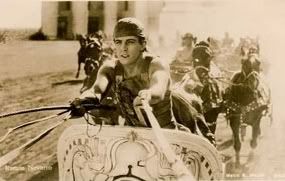
Ramon Novarro in Ben-Hur (1927)
So I got up early this morning to watch TCM's showing of Across to Singapore. Unfortunately, it's not available on DVD and, since it's a silent, it's not so likely to show up soon on TCM. Ramon Novarro stars as Joel, the youngest of the four Shore brothers, the oldest three of whom are seamen. Joel's in love with Priscilla Crowninshield (Joan Crawford), but so is his older brother Mark, played by Ernest Torrence, who in real life was 21 years older than Novarro -- but more on that later. Older brother Mark is betrothed to Priscilla, much to the chagrin of both her and Joel.
Things change, though, when Joel too becomes a seaman and goes off on Mark's next voyage. Mark sees him as immature, and when they get to Singapore, Mark orders Joel out of a bar and back to the ship, just before Mark gets stabbed by a gang led by a sailor overlooked by Mark for first mate in favor Joel. The new captain has Joel put in irons for the voyage home, and here's where we have to congratulate the make-up department: despite having spent several months at sea in harsh weather, followed by several months in irons below decks in the brig, when the ship returns home, Novarro is impossibly photogenic, as though he's just come from the set of the 1920s equivalent of Dawson's Creek. Novarro was 28 at the time, and since his age isn't actually given in the movie, we can be generous and suggest that MGM weren't too egregious in their casting. Torrence, on the other hand, was 49 when Across to Singapore was made, and looks every day of his 49 years, and then some, with a winswept, craggy, and totally unappealing face. It's easy to see why Crawford's Priscilla wouldn't want this man.
Eventually, Joel proves that his ending up in irons was an injustice, and he and Priscilla end up together courtesy of an unbelievably melodramatic ending. Joel has the good fortune to retain his boyish good looks, despite having spent several more months at sea, and getting punched around in a fight.
As I mentioned, Across to Singapore isn't available on DVD, probably in part because the print isn't all that good, really showing wear from its 80 years. If you'd like to watch Novarro on DVD, your best bet would be Novarro's best-known movie, the 1927 silent version of Ben Hur.
One final note about Across to Singapore: it's based on the novel "All the Brothers Were Valiant", and under that title, the movie was made earlier as a silent, and then in the 1950s. The novel was written by Ben Ames Williams, the same man who wrote Leave Her to Heaven
Posted by
Ted S. (Just a Cineast)
at
11:04 AM
0
comments
![]()
![]()
Labels: Silent
Sunday, March 16, 2008
Eine Nacht zu erinnern
Everybody knows the story of the Titanic: hubristic shipbuilders build the hitherto biggest ship in history, and claim that it's "unsinkable", only to have the ship hit an iceberg on its maiden voyage and sink, killing some 1400 people. The story has been told on film many times, and thankfully to the best of my knowledge, Hollywood has never tried to make a version in which the Titanic does not in fact sink. (They did make The Unsinkable Molly Brown, but that's based on a true story of one of the survivors.)
Perhaps one of the most curious versions is one made in 1943 in Nazi Germany, which is airing overnight at 2:30 AM on March 17, as part of TCM's Imports series. The story itself is about as accurate as any other version of the movie, although having been made in Nazi Germany, there certainly is some propaganda. This version paints the executives of the White Star Line as greedy capitalists to a much greater extent than Hollywood would have done in the studio era, or in what is probably the best cinematic look at the disaster, A Night to Remember. (To be fair, though, the Hollywood of 2008 would probably revel in propagandizing against large companies. Remember Denzel Washington's idiotic line in the remake of The Manchurian Candidate that "this is what happens when you have rich people doing bad science"?) Also, there's a ludicrous casting change as one of the ship's officers is not English, but German -- and this is the only officer who shows any virtue in the run-up to the disaster, recognizing the dangers of going too fast through iceberg-infested waters where his English superiors steam blithely on.
What is more interesting about this version, though, is the back story. The original director, Herbert Selpin, faced a critic far tougher than Siskel and Ebert, with their two thumbs down: watching over the production was Joseph Goebbels, the man responsible for Nazi propaganda. Goebbels eventually concluded that showing a movie about a sinking ship probably wouldn't be a good idea for the Germans of 1943, who faced air-raids and, with the defeat at Stalingrad, a proverbial sinking ship of their own. So Goebbels had the director arrested; soon thereafter Selpin was found dead in his jail cell under mysterious circumstances. This version of the Titanic story was banned in Nazi Germany, although interestingly enough it was allowed to be shown in occupied France, where audiences loved it, making it a big hit.
It's not the greatest version of the Titanic disaster, although it's more than passable, and not dreadfully overlong or filled with crappy Céline Dion music the way James Cameron's version is. It's worth watching, and not just for the historical curiosity of seeing the Nazi take on a very British disaster. It's also available on DVD, although as an import, it can be a bit pricey.
Posted by
Ted S. (Just a Cineast)
at
11:06 AM
0
comments
![]()
![]()
Labels: Foreign
Saturday, March 15, 2008
Powell and Loy return!
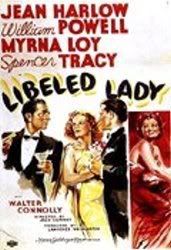
A few days ago, I mentioned William Powell and Myrna Loy appearing together in Manhattan Melodrama. One of their great comedies, Libeled Lady, will be airing on TCM at 8:00 AM ET on March 16. Loy plays the title role, socialite Connie Allenbury, who is libeled about a romantic tryst by the newspaper publisher Mr. Haggerty (played by Spencer Tracy). She sues him, and he, trying to get out of the suit, hires noted detective Bill Chandler (that's Williams Powell) to seduce Connie so that there will no longer be any libel. What actually happens, however, is that Chandler falls in love with Allenbury, with hilarious consequences. Also appearing, as Haggerty's long-suffering fiancée Gladys, is Jean Harlow. Note her and Tracy on the right of the photo, with Loy and Powell on the left. Finally, Mr. Allenbury, Connie's father, is played by Walter Connolly, who also appeared as the father in the classic screwball comedy It Happened One Night.
Loy plays the title role, socialite Connie Allenbury, who is libeled about a romantic tryst by the newspaper publisher Mr. Haggerty (played by Spencer Tracy). She sues him, and he, trying to get out of the suit, hires noted detective Bill Chandler (that's Williams Powell) to seduce Connie so that there will no longer be any libel. What actually happens, however, is that Chandler falls in love with Allenbury, with hilarious consequences. Also appearing, as Haggerty's long-suffering fiancée Gladys, is Jean Harlow. Note her and Tracy on the right of the photo, with Loy and Powell on the left. Finally, Mr. Allenbury, Connie's father, is played by Walter Connolly, who also appeared as the father in the classic screwball comedy It Happened One Night.
Libeled Lady is in itself a hugely enjoyable movie, but there's a bit of a backstory that's interesting. At the time, Tracy hadn't really done any comedies; most of his movies had been at Fox, with a number of less savory types included. Libeled Lady showed that Tracy could really do comedy, and this movie, combined with another 1936 release, San Francisco, helped make Tracy a big star.
It's fairly well-known, but despite appearing together in a slew of movies, William Powell and Myrna Loy were not romantically involved. At the time Libeled Lady was released, Powell had gone through a divorce from Carole Lombard, and was quite smitten with Jean Harlow. (Well, who wouldn't be?)
Watch for the opening credits. With so much star power, it's only logical to conclude that there was going to be a dispute over who should get top billing. So MGM came up with an interesting solution that obviated this problem: the four stars are walking together arm in arm, with their names being superimposed over them. All four stars ger more or less simultaneous top billing. (I do wonder, however, whether anybody complained about being further to the right of anybody else.)
Libeled Lady was remade by MGM as the Technicolor movie Easy to Wed, starring Lucille Ball, Van Johnson, and Esther Williams. Both versions are available on DVD.
Posted by
Ted S. (Just a Cineast)
at
4:40 PM
0
comments
![]()
![]()
Labels: Myrna Loy, Spencer Tracy, William Powell
Friday, March 14, 2008
Writer's Block
I was having a difficult time thinking of a subject for today's post, until I thought about writer's block: "Hmm," I thought to myself, "movies about writers would be a quick way of dashing off a blog post for today." And so that's what you're going to get.
I could mention biopics about writers, such as The Life of Émile Zola. Paul Muni plays the title role, the French writer who defended the railroaded Jewish military officer with his famous essay "J'accuse!".
There have been several movies about advertising writers, and perhaps this would be a good topic for a post all its own. For today, however, I'll just point out adman Cary Grant in the title role as Mr. Blandings Builds His Dream House.
Newspaper writers are a very common source of inspiration for Hollywood. One of the best movies about the newspaper biz is His Girl Friday, starring Rosalind Russell as the writer and the aforementioned Grant as her editor; this one is airing on TCM at noon ET on March 16.
Then there are the screen writers. The most famous of these would be William Holden playing Joe Gillis in Sunset Blvd., working for the insane Norma Desmond (Gloria Swanson) on her screenplay.
But there is at least one movie dealing more directly with the idea of writer's block: The Lost Weekend. (Technically, Cary Grant is suffering from writer's block too in Mr. Blandings; he can't come up with a good slogan for Wham hams.) Ray Milland won a Best Actor Oscar for his portrayal of Don Birnam, a writer suffereing from writer's block who can only face the day by drinking. I'm not much of a drinker, but supposedly this is relatively realistic, or at least realistic enough that the studios were skittish about releasing such a depressing movie when it was made back in 1945.
Fortunately, all of the films I've mentioned above are available on DVD.
Posted by
Ted S. (Just a Cineast)
at
5:54 PM
0
comments
![]()
![]()
Labels: Cary Grant
Thursday, March 13, 2008
Dame May Whitty
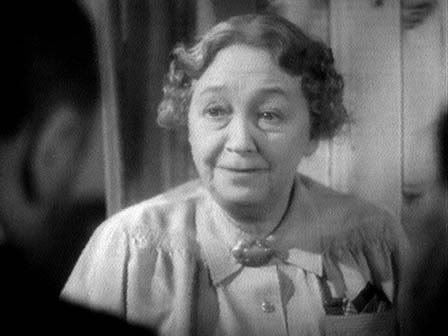
Dame May Whitty, 1965-1948
TCM aired Alfred Hitchcock's The Lady Vanishes this evening in prime time. Dame May Whitty plays the title role; governess Miss Froy, who's returning from a made-up country in Central Europe back to England. She meets young woman Iris Henderson (played by Margaret Lockwood) just before boarding the train, but Iris wakes up during the train ride to discover that Froy has gone missing! And she can't get anybody to believe that Froy even existed -- until Gilbert Redman (Michael Redgrave) comes to believe it. I won't give away any more of the story line, except to say that it's filled with Hitchcock's twists, turns, and a MacGuffin. If you missed The Lady Vanishes on TCM, you'll be pleased to know that it's out on DVD.
If you want to see more of Dame May Whitty, though, you can just tune in to TCM on March 14 at 8:00 PM ET: TCM will be showing Gaslight. Ingrid Bergman stars as Paula Alquist, a young woman whose aunt, a famous opera singer, was murdered. She's in Italy recovering, where she meets Gregory Anton (played by the suave Charles Boyer). They fall in love right away, get married, and return to Paula's old home in London. But all is not right with their marriage, as Gregory is browbeating Paula, and she seems to be going mad as a result. Why is he doing it? Well, that would give away the whole story!
Dame May Whitty plays Bessie Thwaites, an elderly woman who meets Paula in Italy at the start of the movie, and then is surprised to find that they're neighbors in London. Her role isn't as big here as it is in The Lady Vanishes, but she's still fun to watch. The other supporting roles, however, may be more interesting: Joseph Cotten plays a Scotland Yard detective who suspects something's going wrong with Paula, and is determined to figure out what. He'd be fine if he were playing an American detective, but as a Scotland Yard man, he seems miscast. The best of the supporting roles, however, is that of Gregory and Paula's young maid: that's a teenaged Angela Lansbury in her first movie role.
Gaslight is also available on DVD.
Posted by
Ted S. (Just a Cineast)
at
10:35 PM
0
comments
![]()
![]()
Labels: Alfred Hitchcock
Wednesday, March 12, 2008
Governor Gantry
 One of the reasons to spend time watching classic movies is to get away from our dreadful current political culture. However, I cannot help but think of some of the movies that would fit the resignation of our vile Willie Stark of a Governor here in New York. Sure, the above reference to All the King's Men would fit, and on a political blog I read, somebody smartly mentioned Rain. But I've recommended Joan Crawford in my last two posts; besides, I'd like to recommend something with a little more class: Manhattan Melodrama.
One of the reasons to spend time watching classic movies is to get away from our dreadful current political culture. However, I cannot help but think of some of the movies that would fit the resignation of our vile Willie Stark of a Governor here in New York. Sure, the above reference to All the King's Men would fit, and on a political blog I read, somebody smartly mentioned Rain. But I've recommended Joan Crawford in my last two posts; besides, I'd like to recommend something with a little more class: Manhattan Melodrama.
William Powell stars as Jim Wade, an honest man who goes from lawyer to prosecutor to governor, who has an interesting relationship with gangster Blackie Gallagher (Clark Gable).  The two grew up together -- watch for yet another appearance by an adolescent Mickey Rooney as the young Blackie, who is already at this young age a small-time chiseler. Wade and Gallagher both fall for the same woman (more on her later), and Gallagher eventually helps Wade become governor, albeit without Wade's knowledge. However, that surreptitious help is eventually discovered, leading to a crisis for the Wade administration. There is a deft resolution to the problem, however, which would satisfy the folks involved in policing the Production Code.
The two grew up together -- watch for yet another appearance by an adolescent Mickey Rooney as the young Blackie, who is already at this young age a small-time chiseler. Wade and Gallagher both fall for the same woman (more on her later), and Gallagher eventually helps Wade become governor, albeit without Wade's knowledge. However, that surreptitious help is eventually discovered, leading to a crisis for the Wade administration. There is a deft resolution to the problem, however, which would satisfy the folks involved in policing the Production Code.
Playing love interest Eleanor Packer is Myrna Loy. 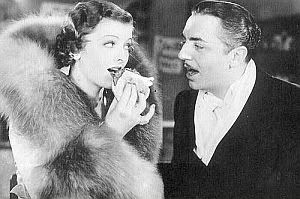 Loy's isn't the most important character in the movie; Powell and Gable get much more of the screen time. But it's really interesting to see this particular pairing of Powell and Loy. Most of the movies starring William Powell and Myrna Loy are comedies -- the six "Thin Man" movies are technically mysteries, but there's a lot of comedy in them. Their other movies, like Libeled Lady and Love Crazy, are straight-up screwball comedies. But both Powell and Loy were good at drama, and show it here. Gable is also quite good as a gangster, and indeed spent quite a bit of time early on in his career playing suave guys with dubious morality: A Free Soul and San Francisco both come to mind.
Loy's isn't the most important character in the movie; Powell and Gable get much more of the screen time. But it's really interesting to see this particular pairing of Powell and Loy. Most of the movies starring William Powell and Myrna Loy are comedies -- the six "Thin Man" movies are technically mysteries, but there's a lot of comedy in them. Their other movies, like Libeled Lady and Love Crazy, are straight-up screwball comedies. But both Powell and Loy were good at drama, and show it here. Gable is also quite good as a gangster, and indeed spent quite a bit of time early on in his career playing suave guys with dubious morality: A Free Soul and San Francisco both come to mind.
Interestingly, Manhattan Melodrama is the movie gangster John Dillinger was watching when he was shot to death after exiting a movie theater. It is available on DVD and, although a big change of pace from the other Powell/Loy movies, is still well worth watching.
Posted by
Ted S. (Just a Cineast)
at
2:18 PM
0
comments
![]()
![]()
Labels: Clark Gable, Myrna Loy, William Powell
Tuesday, March 11, 2008
More Joan Crawford
This time, we get an older Crawford in The Caretakers, airing at 2:30 AM ET on March 12 on TCM. (Note that this means 11:30 PM on March 11 for those out on the west coast.) In this 1963 movie, Crawford plays the head nurse at a mental institution. Robert Stack plays the head doctor, and he's a "progressive" who wants to try new ways of treating the patients. Unfortunately, this raises havoc for Crawford's nursing staff, and so she fights him at every turn.
That's not the only thing about this movie that's unfortunate. Although the above sounds like an interesting enough idea for drama, it's also the sort of situation that's easily made exploitative, with the patients suffering by being treated as caricatures. And that's what happens in this movie.
Still, it's fun to watch Stack and Crawford, as well as the supporting cast. An aging Herbert Marshall appears as one of the doctors, and Polly Bergen (Gregory Peck's wife in the original Cape Fear) probably gets the highlight as a woman who suffers a nervous breakdown in a movie theater in this film's opening sequence.
Like Ice Follies of 1939, this one is liable to be released on DVD only as part of a completist edition of the movies of Joan Crawford. God knows she made enough B-grade stuff in the 1960s after What Ever Happened to Baby Jane?
Posted by
Ted S. (Just a Cineast)
at
4:02 PM
0
comments
![]()
![]()
Labels: James Stewart, Joan Crawford
Monday, March 10, 2008
Ice Castles
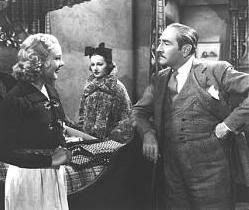 Sonja Henie, seen here with Adolphe Menjou in her first feature film One in a Million, is the Norwegian figure skater who won gold medals at the Olympics in 1928, 1932, and 1936. At the time, the Olympics were strictly for amateurs, so she decided to make some money skating by coming over to Hollywood, where she was signed to a contract by Twentieth Century-Fox. She made a string of movies that were reasonable entertainment but nothing that would be considered truly great; if you wish to judge for yourself you can watch her in Sun Valley Serenade, March 14 at 6:00 AM ET on the Fox Movie Channel.
Sonja Henie, seen here with Adolphe Menjou in her first feature film One in a Million, is the Norwegian figure skater who won gold medals at the Olympics in 1928, 1932, and 1936. At the time, the Olympics were strictly for amateurs, so she decided to make some money skating by coming over to Hollywood, where she was signed to a contract by Twentieth Century-Fox. She made a string of movies that were reasonable entertainment but nothing that would be considered truly great; if you wish to judge for yourself you can watch her in Sun Valley Serenade, March 14 at 6:00 AM ET on the Fox Movie Channel.
But this isn't really a thread about Henie; instead it's a look at Hollywood's derivative and copycat nature that existed even back in the 1930s. The executives at MGM saw what Fox was doing with Sonja Henie, and wanted to make money of their own by making skating movies. So what did they do? They put on the Ice Follies of 1939, which TCM is airing Tuesday, March 11, at 7:45 AM. MGM contract player Joan Crawford (stop laughing; if you think the idea of Crawford on ice skates is bad, wait until you see what's coming next!) is on skates in what must be the most original plot since 42nd Street: she's married to a fellow skater, played by James Stewart (See? -- I told you there was more!). Into their lives walks another skater (Lew Ayres), whose presence causes their marriage to become strained as Stewart and Ayres become romantic rivals. It's all ended with a Technicolor scene involving the three stars, and every ice follies player not under contract to another studio the MGM bosses could find.
You might remember Lew Ayres for his Oscar-nominated role in Johnny Belinda. And perhaps it would have been more interesting if TCM had put the cast of Johnny Belinda on ice instead. I can only imagine Jane Wyman gesticulating wildly out on the ice, and poor old Agnes Moorhead struggling to maintain her balance.
Ice Follies of 1939 is not available on DVD, and probably won't be until the owners of the MGM library decide to put out a completist retrospective of the MGM careers of either Crawford or Stewart.
Posted by
Ted S. (Just a Cineast)
at
1:51 PM
0
comments
![]()
![]()
Labels: Adolphe Menjou
Sunday, March 9, 2008
Shakespeare in heat
TCM is airing a night of movies based on the tragedies of William Shakespeare on March 10. I'd like to point out one a classic movie based on one of Shakespeare's comedies instead: Warner Bros.' 1935 version of A Midsummer Night's Dream. The play is a bit of a slog by modern standards due to the language and the complexity of the relationships amongst the various characters, but the richness of the Bard's work, combined with the assets of the studio system, make this one of the more interesting (in a good sense) Shakespeare adaptations out there.
Two pairs of lovers (Ian Hunter and Verree Teasdale as Theseus and Hippolyta; and Olivia de Haviland and Ross Alexander as Hermia and Demetrius) are betrothed to be married, and spend the night in the forest of Arden on their way to Theseus and Hippolyta's wedding.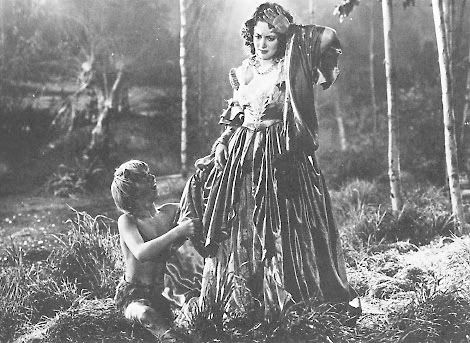 Into all this walks a troupe of actors led by Nick Bottom, played by James Cagney in a very atypical role for him; and the mischievous spirit Puck, played by a fourteen-year-old Mickey Rooney in the one time MGM lent him out to another studio. When they saw what a good job Rooney did as Puck, the MGM brass decided to keep him for themselves. Puck decides to create mayhem for all involved by casting various spells that will make the characters fall in and out of love with all the wrong people, instead of with their respective betrothed; this includes Warners' musical stalwart Dick Powell, who is miscast here but tries gamely. The highlight of all this mayhem is that Bottom is given the head of a horse, a feat Cagney pulls off surprisingly well, considering he was used to playing gangster roles. Rooney is also wonderful; even if you don't normally like his antics, they're exactly what the role of Puck calls for, and Rooney's normal obnoxiousness is used to great effect. He, after Cagney, is the highlight of the movie, and that's saying something considering Olivia de Havilland and a slew of great character actors appear
Into all this walks a troupe of actors led by Nick Bottom, played by James Cagney in a very atypical role for him; and the mischievous spirit Puck, played by a fourteen-year-old Mickey Rooney in the one time MGM lent him out to another studio. When they saw what a good job Rooney did as Puck, the MGM brass decided to keep him for themselves. Puck decides to create mayhem for all involved by casting various spells that will make the characters fall in and out of love with all the wrong people, instead of with their respective betrothed; this includes Warners' musical stalwart Dick Powell, who is miscast here but tries gamely. The highlight of all this mayhem is that Bottom is given the head of a horse, a feat Cagney pulls off surprisingly well, considering he was used to playing gangster roles. Rooney is also wonderful; even if you don't normally like his antics, they're exactly what the role of Puck calls for, and Rooney's normal obnoxiousness is used to great effect. He, after Cagney, is the highlight of the movie, and that's saying something considering Olivia de Havilland and a slew of great character actors appear
Eventually, we get to the wedding, and this is where the studio system half of the fun begins. Amongst Nick Bottom's troupe, who are there to perform at the royal wedding, are several character actors we wouldn't normally think of as being Shakespearean actors: Frank McHugh and Joe E. Brown, who gets to perform one skit in drag. Despite not being Shakespearean actors, these character actors do a remarkable job, probably because what they're doing isn't all that Shakespearean, but instead relatively light comedy. Joe E. Brown's antics and facial expressions work particularly well here. Veteran 1930s character acter Grant Mitchell plays Hermia's father, while Victor Jory plays Oberon, the king of the fairies; watch also for veteran British butler Arthur Treacher in a bit part as well.
In addition to the interesting cast, there's lush cinematograpy made to look like an actual dream sequence that's as beautiful as anything made in the 1930s, and rivalling the work of Gregg Toland in the 1940s.
A Midsummer Night's Dream was the first movie Olivia de Havilland made. (However, it was not the first one released; that would be Alibi Ike, starring the aforementioned Joe E. Brown.) It is available on DVD as well.
Posted by
Ted S. (Just a Cineast)
at
8:46 PM
0
comments
![]()
![]()
Labels: Dick Powell, James Cagney, Mickey Rooney
Saturday, March 8, 2008
Daylight Savings Time
The second Sunday in March marks the beginning of Daylight Savings Time in the US, when we all "spring forward" by moving our clocks one hour forward (well, not the people in Arizona and Hawaii). In honor of this day, I'd like to recommend The Clock (MGM, 1945).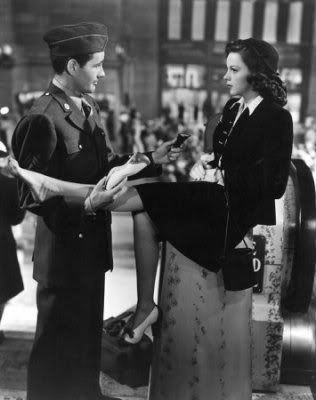 Robert Walker stars as Cpl. Joe Allan, a serviceman who has two days' leave in New York City. While in Penn Station, Allan helps the young Alice Mayberry (Judy Garland) when she breaks the heel of her shoe. She agrees to show him the sights, and they quickly fall in love, despite the fact that she's already got a date for that night. Well, she breaks the date, meets Joe under the clock at the Astor (hence the title of the movie), and proceeds to begin a whirlwind, if unorthodox, romance that lasts for the rest of his leave.
Robert Walker stars as Cpl. Joe Allan, a serviceman who has two days' leave in New York City. While in Penn Station, Allan helps the young Alice Mayberry (Judy Garland) when she breaks the heel of her shoe. She agrees to show him the sights, and they quickly fall in love, despite the fact that she's already got a date for that night. Well, she breaks the date, meets Joe under the clock at the Astor (hence the title of the movie), and proceeds to begin a whirlwind, if unorthodox, romance that lasts for the rest of his leave.
The romance is unorthodox because of whom they meet along the way: they get stuck in Central Park after the buses have stopped for the night, and kindly milkman Al Henry (played by veteran character actor James Gleason) agrees to take them home, although they'll have to go with him on his rounds first. Things get tough, however, when Henry gets socked by a drunk at one of the deliveries (played by Keenan Wynn), and Joe and Alice have to finish the milkman's rounds for him. Afterwards, they take him home, where we meet, Mrs. Henry, who is played by James Gleason's real-life wife of over 40 years, Lucile.
I won't give away how the romance ends, but The Clock is a wonderful movie. It's Garland's first as an adult, and she doesn't do any singing or dancing, either. To be honest, I'm not generally that much of a fan of Garland's work, since I don't care too much for the Freed Unit musicals, and in her later work, she became almost a caricature of herself. But in The Clock, Garland shows that she was actually quite a capable actress, despite having been badly misused by MGM for all those years. Walker is fine as the soldier, and James Gleason is a delight as the milkman; like so many of the character actors in the days of the studio system, Gleason's presence brightens every movie he's in, and oftentimes studio movies are just as fun to watch for the charactor actors in the cast as they are for the stars.
The other highlight is the set design: the scenes in Penn Station were not filmed in New York, as the station was just too busy, and filming would have been a logistical impossibility. Instead, a recreation was created on the MGM back lot, with stunning accuracy.
Happily, The Clock is available on DVD.
Posted by
Ted S. (Just a Cineast)
at
4:57 PM
0
comments
![]()
![]()
Labels: James Gleason, Judy Garland
Friday, March 7, 2008
Aldo Ray, redux
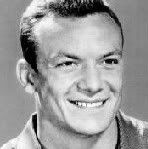 I briefly mentioned Aldo Ray when TCM aired Pat and Mike several weeks back. Aldo Ray returns to get a starring role, in Nightfall, airing March 8 at 8:30 AM ET on TCM. In this movie, Ray stars as a man with a bit of a past: while he was hunting with a friend (played by Frank Albertson), a pair of bank robbers showed up with $350,000, but due to a snafu, Albertson gets killed, and Ray runs off with the money bag, dropping it in the snow by Ray with the robbers hot on his heels. Now, he's in Los Angeles, and the robbers want to know where their money is. The $350,000, of course, would be
I briefly mentioned Aldo Ray when TCM aired Pat and Mike several weeks back. Aldo Ray returns to get a starring role, in Nightfall, airing March 8 at 8:30 AM ET on TCM. In this movie, Ray stars as a man with a bit of a past: while he was hunting with a friend (played by Frank Albertson), a pair of bank robbers showed up with $350,000, but due to a snafu, Albertson gets killed, and Ray runs off with the money bag, dropping it in the snow by Ray with the robbers hot on his heels. Now, he's in Los Angeles, and the robbers want to know where their money is. The $350,000, of course, would be
buried under the big "W". Er, not that big W; instead, the money bag is somewhere in the snow in Wyoming, not far from where Ray and Albertson were hunting. But the only thing is, thanks to all that snow, the roads are impassable, so Ray is playing a waiting game, waiting for the snow to melt while simultaneously trying to avoid the bank robbers. Oh, and there's a detective on his trail, too....
While escaping from the robbers, Ray hides in the apartment of Anne Bancroft, here playing a lovely young model. What this unfortunately means for her is that she's in danger too, eventually being forced to join Ray on the run.
Nightfall is, at 79 minutes, a fairly short movie, and one less action than you might think: although Ray is on the run, the scenes with Bancroft are surpringly quiet; especially one scene where she's on the job modeling clothes and discovers that the robbers have spotted her, forcing her to make an escape in a designer gown. Eventually, we do get some excitment once everybody gets to Wyoming at the beginning of spring, but even here the action is understated. And yet, that works for this movie. Directed by Jacques Tourneur, who might be best knwon for the horror classics he made for Val Lewton such as Cat People, Nightfall is a little gem that deserves more exposure than the cast of relatively less prestigious stars (not counting Bancroft) would imply.
Sadly, Nightfall is not available on DVD.
Posted by
Ted S. (Just a Cineast)
at
2:03 PM
0
comments
![]()
![]()
Labels: Anne Bancroft
Thursday, March 6, 2008
Guy Kibbee birthday

Guy Kibbee, 1882-1956
TCM spent the better part of this morning and afternoon celebrating the birthday of Guy Kibbee by showing a mini-marathon of his lesser-known movies. Kibbee was a character actor who played all sorts of older male roles, from a convict in the Errol Flynn movie Captain Blood, to a dirty old man producer in the classic muscial 42nd Street, to a pool player turned society judge in Lady For a Day, to a frontier doctor in Of Human Hearts with James Stewart. But I'd like to recommend two of his movies that are available on DVD:
Gold Diggers of 1933. 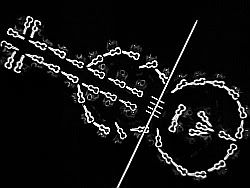 In this movie, Kibbee plays a man with money whom a group of down and out Broadway performers hope will finance their musical. Kibbee himself does a more than adequate job, and the plot isn't that bad, but this movie is more about the musical numbers of Busby Berkeley. Berkeley's style first came to prominence with the aforementioned 42nd Street, but the numbers in Gold Diggers of 1933 are much more elaborate and interesting: in the opening "Dance of the Dollars", a group of chorus girls sing "We're in the Money" with giant gold dollars serving as a sort of codpiece.
In this movie, Kibbee plays a man with money whom a group of down and out Broadway performers hope will finance their musical. Kibbee himself does a more than adequate job, and the plot isn't that bad, but this movie is more about the musical numbers of Busby Berkeley. Berkeley's style first came to prominence with the aforementioned 42nd Street, but the numbers in Gold Diggers of 1933 are much more elaborate and interesting: in the opening "Dance of the Dollars", a group of chorus girls sing "We're in the Money" with giant gold dollars serving as a sort of codpiece. 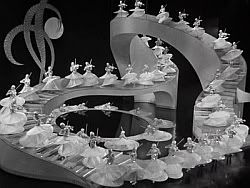 If that's not enough, the "Dance of the Dollars" also has Ginger Rogers singing a verse -- in pig latin! (This alone would be worth the price of admission.) Then there's the two numbers at the end; the first involves an elaborate choreographing of neon violins, as well as enormous staircases that curve in manifold ways; this is followed by the "Song of the Forgotten Man", which is tacked on to provide a social message at the beginning of the New Deal.
If that's not enough, the "Dance of the Dollars" also has Ginger Rogers singing a verse -- in pig latin! (This alone would be worth the price of admission.) Then there's the two numbers at the end; the first involves an elaborate choreographing of neon violins, as well as enormous staircases that curve in manifold ways; this is followed by the "Song of the Forgotten Man", which is tacked on to provide a social message at the beginning of the New Deal.
Earthworm Tractors. In this silly B-comedy, the star is Joe E. Brown, who was best known for his broad facial expressions that he used to good effect in a series of B comedies for Warner Bros. in the 1930s; Brown also played the millionaire who fell in love with Jack Lemmon in Some Like it Hot. Brown plays a man who claims he can sell anything, and winds up working as a salesman for the Earthworm Tractor Co., trying to sell tractors to the rural folk of Mississippi. Guy Kibbee is one of them; although the plot is well-suited to kids, it's a lot of fun to watch Kibbee and Brown try to handle out-of-control farm equipment. It's typical of the double-bills of the era: a movie about 70 minutes with lesser stars that has the obvious look of lower production values than the "prestige" movies -- but one which is still quite entertaining.
Posted by
Ted S. (Just a Cineast)
at
8:53 PM
0
comments
![]()
![]()
Wednesday, March 5, 2008
The dated 60s
I stayed up to watch The President's Analyst on TCM last night. Unfortunately, instead of getting a movie that's a biting satire on the Cold War and the counterculture, I felt I was getting something that's aged very badly.
As for the plot: James Coburn plays psychiatrist Sidney Schaefer, who is called upon to be somebody for the Preisdent to talk to, since the President has such a high-stress job. Hence, the title, The President's Analyst. Unfortunately, the various security bureaucracies surrounding the President decide Dr. Schaefer is too much of a security risk: what happens if the Soviets get a hold of him? So, they decide to get rid of him -- except that he escapes first, and ends up running for his life, chased after by spies from multiple countries.
The plot, on the face of it, doesn't sound so bad. And yet, I found something quite off in the execution. Not only was I getting something from the hippie era (which in and of itself doesn't necessarily make for a bad movie), I felt as though it was stuck in the hippie era, and wasn't translating well to 2008. And yet, other, earlier movies don't feel similarly dated, even those that deal with politics. Why is that?
I'm not quite certain, but my first guess would be that The President's Analyst is in color. There's something about the less-vibrant color from after the mid-1950s that doesn't fit in all that well today, while black and white seems timeless. One, Two, Three deals with the Cold War, and yet, it's still quite the farce today. Likewise with Ninotchka, which also involves Soviet agents, in an even earlier era.
And yet, there are other color movies that still play well in 2008. I've recommended Yours, Mine, and Ours, which clearly shows the styles of the 1960s, and yet retains an air of being an evergreen. As I mentioned about Yours, Mine, and Ours, it deals with topics that are always relevant -- love and dealing with new relatives -- and does it with dignity and class.
However, there are movies involving characters much closer to hippies that still fit in in 2008; much of the humor of Cactus Flower revolves around the idea that there's a generation gap going on between the two couples. But there's always been a generation gap.
So, perhaps it's just that The President's Analyst is trying too hard to be hip. There are quite a few movies from the 1960s that give off the vibe that this is what happens when the stuffy studio executives try to develop a plot that will appeal to the hip youngsters of today. Instead, what you get is the older people's caricature of youth, with the same profound unfunniness.
Or, perhaps it's just me. I wasn't around for that era, and to be honest, I've long been sick and tired of the idea that every event today has to be filtered through a prism of events that happened between the assassination of John F. Kennedy and the resignation of Richard Nixon. And perhaps that clouds my view of the movies and other culture of that era. What say ye, fans of The President's Analyst?
(The movie is also available on DVD, in case you haven't seen it and would like to judge for yourself.)
Posted by
Ted S. (Just a Cineast)
at
4:26 PM
0
comments
![]()
![]()
Tuesday, March 4, 2008
Six degrees of Kevin Bacon
It's odd the way various movies come to mind. Yesterday, I heard a report on the death of Canadian jazz/blues guitarist Jeff Healy. He wasn't that commercially successful here in the States; you might remember him for his one hit "Angel Eyes". When I mentioned his passing on another forum I frequent, somebody who knows my love of classic movies said he was surprised I didn't mention Healy's brief appearance performing behind Patrick Swayze in Road House. (Well, it is an easy enough movie to forget.) This reminded me not of Swayze's famous turn in Dirty Dancing, but of his as-forgettable-as-Road-House movie Sommersby. And Sommersby reminded me of the original, The Return of Martin Guerre (Original French title: Le Retour de Martin Guerre).
The Return of Martin Guerre stars Gérard Depardieu in the title role, that of a 16th century Frenchman returning home from several years of military service. Everybody welcomes him, of course, despite the fact that those years of service have changed him quite a bit. Then, however, another ex-serviceman comes along, claiming that this man is in fact not Martin Guerre. Is Depardieu really Martin Guerre, or isn't he? And if he isn't, what are the locals to make of all the good works he did while he was putatively Martin Guerre? And what of Martin Guerre's wife, who loved this man? If she loved this man thinking he was Martin Guerre, can she still love him for who he's been since entering her life, despite his not being Martin Guerre?
Being a foreign film, The Return of Martin Guerre has a rather different feel from Hollywood movies, so you should expect something with a rather deliberate and thoughtful pace. I first saw this movie many years ago when I was in college, on the local PBS channel, and remembered being very impressed by it. Fortunately, it is available on DVD, although, being a foreign import, carries a high price according to Amazon. It is, however, available on Netflix.
Posted by
Ted S. (Just a Cineast)
at
11:14 AM
0
comments
![]()
![]()
Labels: Foreign
Monday, March 3, 2008
Tastes great, less filling
Every Tuesday night in March, TCM is looking at psychiatry in the movies. One of this week's selections is Now, Voyager, at 1:45 AM ET on March 5. (That's 10:45 PM March 4 on the west coast; don't get me started on TCM's days beginning not at midnight, but at 6:00 AM.) This movie is generally considered a classic, so you probably know the story already: Bette Davis plays an old maid who suffers a nervous breakdown at the hands of a domineering mother; she's saved by psychiatrist Claude Rains who sends her on a cruise to South America where she meets and falls in love with divorcé Paul Henried.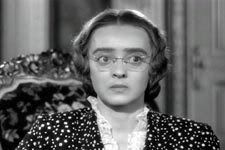 I'd like to dwell on that nervous breakdown for a minute. "God, talk to me!" wails Davis, after being prodeed by Bonita Granville. "You people like making fun of me, don't you?" Well, yes. We like making fun of your over-the-top scenery chewing. It's always good for a laugh. Indeed, I find one of the best things about watching Bette Davis' movies is waiting for those scenes when she goes off and starts overacting. A few of my favorites:
I'd like to dwell on that nervous breakdown for a minute. "God, talk to me!" wails Davis, after being prodeed by Bonita Granville. "You people like making fun of me, don't you?" Well, yes. We like making fun of your over-the-top scenery chewing. It's always good for a laugh. Indeed, I find one of the best things about watching Bette Davis' movies is waiting for those scenes when she goes off and starts overacting. A few of my favorites:
In 1934's Of Human Bondage, there is the famous scene of Davis telling off poor Leslie Howard. "And when I kissed you, I used to wipe my mouth," she tells him, and then, making an exaggerated gesture of wiping her mouth on her sleeve, repeats, "wipe -- my -- mouth!" It's supposed to be one of the key dramatic moments of the movie, but I can't help but laugh at it. "I want the truth," says Howard. "You can't handle the truth!" replies Davis. (Er, no; that's a different movie, but the sentiment is the same.)
Davis spends much of What Ever Happened to Baby Jane? over the top as she torments poor Joan Crawford, although in fairness to her, most of the time, the script calls for it. Bette would repeat this in Hush, Hush, Sweet Charlotte, but again here, it's due in large part to the typecasting she had gotten as Baby Jane.
My favorite Davis rant, however, is probably in In This Our Lives. Bette Davis has just run down a pedestrian, and blamed it on a young black man, although it looks like her attempt to frame him is doomed to failure. Davis looks to her rich uncle (played by the lovable Charles Coburn) for consolation, but he's just discovered he's terminally ill and only has months to live. When he tells Davis he's going to die, compassionate Bette responds, "You've lived your life! What about mine? Mine's only just begun!"
What's your favorite Bette Davis rant?
Posted by
Ted S. (Just a Cineast)
at
9:43 AM
0
comments
![]()
![]()
Labels: Bette Davis
Sunday, March 2, 2008
Thank heaven for little harlots
... for little harlots grow up to be the women of Pre-Code movies. Tuesday, March 4 sees the release of the Forbidden Hollywood Collection, Vol. 2, including five Pre-Code movies. In honor of this, TCM is showing all five movies starting at 8:00 PM ET on Monday.
I've seen four of the five, but since two of those four won Oscars (The Divorcée at 8:00 PM and A Free Soul at 3:45 AM Tuesday), I'd like to mention the other two. First up is Night Nurse, at 10:45 PM Monday. Barbara Stanwyck stars as nurse Lora Hart. There's not much money in working at the hospital, so she takes a job working as a nurse for two sick rich children. 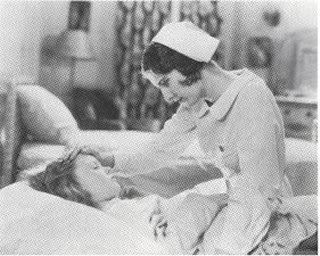 After examining the children, she determines that the problem is that they're deliberately being neglected! And this is being done so that they'll die, and the adults left behind can have the trust-fund money for themselves! This must have been fairly shocking stuff for 1931, as it's an idea that would be shocking even now, three-quarters of a century later. And who's responsible for this? Why, it's the chauffeur, played by a young Clark Gable before he became a star (this movie and especially A Free Soul, also from 1931, are the movies that made Gable a star). When Nurse Hart tries to inform the kids' mother of what's going on, she finds that the mother is a dissolute woman, leading a life of drinking at parties downstairs, too drunk to care about the warnings of what will happen to her children. (Or is she in on the plot?) The cast also includes Joan Blondell as Stanwyck's fellow nurse, and early 1930s Warner's stalwart Ben Lyon as a small-time bootlegger to whom Stanwyck and Blondell minister under the table, and who eventually comes back to save the day for Stanwyck. In addition to the adult subject material, watch for a pre-Code scene of Stanwyck and Blondell changing their clothes in the hospital changing room, showing off their 1930s undergarments.
After examining the children, she determines that the problem is that they're deliberately being neglected! And this is being done so that they'll die, and the adults left behind can have the trust-fund money for themselves! This must have been fairly shocking stuff for 1931, as it's an idea that would be shocking even now, three-quarters of a century later. And who's responsible for this? Why, it's the chauffeur, played by a young Clark Gable before he became a star (this movie and especially A Free Soul, also from 1931, are the movies that made Gable a star). When Nurse Hart tries to inform the kids' mother of what's going on, she finds that the mother is a dissolute woman, leading a life of drinking at parties downstairs, too drunk to care about the warnings of what will happen to her children. (Or is she in on the plot?) The cast also includes Joan Blondell as Stanwyck's fellow nurse, and early 1930s Warner's stalwart Ben Lyon as a small-time bootlegger to whom Stanwyck and Blondell minister under the table, and who eventually comes back to save the day for Stanwyck. In addition to the adult subject material, watch for a pre-Code scene of Stanwyck and Blondell changing their clothes in the hospital changing room, showing off their 1930s undergarments.
Night Nurse will be followed at midnight on Tuesday (that's 9:00 PM Monday out on the Pacific coast) by Three on a Match. Early 1930's Warner's leading lady Ann Dvorak stars at Vivian Revere, one of three women who were friends in school a decade earlier. Each of them has gone her own way, but by chance, they meet at a restaurant one day and bring each other up to date on what's happened in the intervening years. Mary Keaton (played by the aforementioned Joan Blondell) led a bit of a wild life, spending time in reform school and becoming a nightclub singer; Ruth Westcott (played by Bette Davis in an early supporting role before she became a star with Of Human Bondage) is an eminently practical secretary; and Revere has married a wealthy man. At the restaurant, they all use the same match to light their cigarettes -- and you know the superstition about lighting "three on a match".... 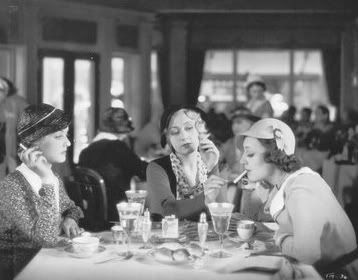 The bad luck this brings is that Vivian has gotten bored with the life of an idle wealthy woman. She's fallen in love with a gangster (Lyle Talbot) and is willing to leave her husband and child for him! And if that's not shocking enough, she also becomes... a dope fiend! He's gotten into some debts, so, to pay them off, he kidnaps her child for the ransom money. In addition to all this adult content, watch for one scene of Bette Davis changing her clothes and wearing just a petticoat. Also, watch for the gangsters: one of them is Humphrey Bogart, in a bit part even before The Petrified Forest pushed him onto the B-list.
The bad luck this brings is that Vivian has gotten bored with the life of an idle wealthy woman. She's fallen in love with a gangster (Lyle Talbot) and is willing to leave her husband and child for him! And if that's not shocking enough, she also becomes... a dope fiend! He's gotten into some debts, so, to pay them off, he kidnaps her child for the ransom money. In addition to all this adult content, watch for one scene of Bette Davis changing her clothes and wearing just a petticoat. Also, watch for the gangsters: one of them is Humphrey Bogart, in a bit part even before The Petrified Forest pushed him onto the B-list.
Posted by
Ted S. (Just a Cineast)
at
3:24 PM
0
comments
![]()
![]()
Labels: Barbara Stanwyck, Bette Davis, Joan Blondell, pre-Code
Saturday, March 1, 2008
The Day of the Jackal
TCM's prime-time offering for February 29 was Fred Zinnemann's 1973 thriller The Day of the Jackal. To be honest, I had never seen this movie before, and enjoyed finally being able to watch it. Despite it being about a historical event to which we know the outcome, Zinnemann's direction makes this an excellent and gripping film. The basic synopsis is that in 1963 France, a group of army officers unhappy with Charles de Gaulle's handling of the situation in Algeria hire an contract killer to assassinate de Gaulle. The assassin, played by Edward Fox is an efficient, ruthless killer. The first half of the movie takes place predominantly outside France, as we see the assassin's detailed preparations -- obtaining multiple false identities, disguises, and a high-powered sniper's rifle he'll be able to smuggle into France.
The basic synopsis is that in 1963 France, a group of army officers unhappy with Charles de Gaulle's handling of the situation in Algeria hire an contract killer to assassinate de Gaulle. The assassin, played by Edward Fox is an efficient, ruthless killer. The first half of the movie takes place predominantly outside France, as we see the assassin's detailed preparations -- obtaining multiple false identities, disguises, and a high-powered sniper's rifle he'll be able to smuggle into France.
Meanwhile, French intelligence figures out that something is up, but they have no idea exactly what: the man they seek has to them no known name, face, or fingerprints. It could be any of fifty million people. 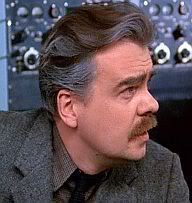 There's only one man in France who has the investigative ability to find the killer the authorities seek: Inspector Lebel, played by Michel Lonsdale (looking rather like Oskar Homolka). Lebel's dogged pursuit, combined with a massive dragnet and some pure dumb luck, gets him to within a few hours of the assassin on numerous occasions, but our antihero always manages to stay one step ahead of the authorities, as he has informants of his own.
There's only one man in France who has the investigative ability to find the killer the authorities seek: Inspector Lebel, played by Michel Lonsdale (looking rather like Oskar Homolka). Lebel's dogged pursuit, combined with a massive dragnet and some pure dumb luck, gets him to within a few hours of the assassin on numerous occasions, but our antihero always manages to stay one step ahead of the authorities, as he has informants of his own.
We know what will happen at the end of the movie: the attempt on de Gaulle's life will fail; in real life de Gaulle resigned the French presidency after the student riots of 1968, and died quietly in 1970. And there's not a whole lot of action. With the exception of one scene at the beginning and the assassin's practice session with his sniper's rifle, we don't get explosions. Nor do we get a French Connection-style car chase. Still, there's always dual tensions. How is the assassin going to get out of the latest tight situation he's in, and how is Lebel going to find him and foil the assassination plot? And by playing these tensions off of one another, Zinnemann is able to create an atmosphere of suspense that keeps us glued to our seats right up until the final bullet is fired.
The Day of the Jackal is available on DVD, in case you missed TCM's recent showing. Although it runs just over two hours, twenty minutes, at no point does it feel like a long movie.
Posted by
Ted S. (Just a Cineast)
at
3:38 PM
0
comments
![]()
![]()
Labels: Fred Zinnemann
